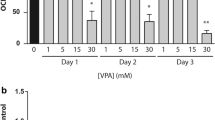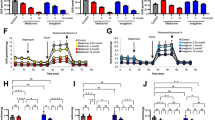Abstract
Freshly established cultures of primary hepatocytes progressively adopt a foetal-like phenotype and display increased production of connexin43. The latter is a multifaceted cellular entity with variable subcellular locations, including the mitochondrial compartment. Cx43 forms hemichannels and gap junctions that are involved in a plethora of physiological and pathological processes, such as apoptosis. The present study was conducted with the goal of shedding more light onto the role of connexin43 in primary hepatocyte cultures. Connexin43 expression was suppressed by means of RNA interference technology, and the overall outcome of this treatment on the hepatocellular proteome and metabolome was investigated using tandem mass tag-based differential protein profiling and 1H NMR spectroscopy, respectively. Global protein profiling revealed a number of targets of the connexin43 knock-down procedure, including mitochondrial proteins (heat shock protein 60, glucose-regulated protein 75, thiosulphate sulphurtransferase and adenosine triphosphate synthase) and detoxifying enzymes (glutathione S-transferase μ 2 and cytochrome P450 2C70). At the metabolomic level, connexin43 silencing caused no overt changes, though there was some evidence for a subtle increase in intracellular glycine quantities. Collectively, these data could further substantiate the established existence of a mitochondrial connexin pool and could be reconciled with the previously reported involvement of connexin43 signalling in spontaneously occurring apoptosis in primary hepatocyte cultures.







Similar content being viewed by others
Abbreviations
- ATP:
-
Adenosine triphosphate
- Cx:
-
Connexin
- DDA:
-
Data-dependent acquisition
- GAPDH:
-
Glyceraldehyde-3-phosphate dehydrogenase
- GO:
-
Gene ontology
- GRP75:
-
Glucose-regulated protein 75
- HSP60:
-
Heat shock protein 60
- IPI:
-
International protein index
- LC/MS:
-
Liquid chromatography/mass spectrometry
- LOWESS:
-
Locally weighted scatterplot smoothing
- LTQ:
-
Linear ion trap
- NMR:
-
Nuclear magnetic resonance
- OT:
-
Orbitrap
- PbAE2:
-
1,6-Hexanediol diacrylate-based poly-beta-aminoester
- PBS:
-
Phosphate-buffered saline solution
- RF:
-
Relative frequence
- SDS–PAGE:
-
Sodium dodecyl sulphate polyacrylamide gel electrophoresis
- siRNA:
-
Small interfering RNA
- TBS:
-
Tris-buffered saline solution
- TMT:
-
Tandem mass tags
- TSP:
-
Trimethylsilyltetradeuteropropionic acid
References
Boengler K, Ruiz-Meana M, Gent S, Ungefug E, Soetkamp D, Miro-Casas E, Cabestrero A, Fernandez-Sanz C, Semenzato M, Di Lisa F, Rohrbach S, Garcia-Dorado D, Heusch G, Schulz R (2012) Mitochondrial connexin 43 impacts on respiratory complex I activity and mitochondrial oxygen consumption. J Cell Mol Med 16:1649–1655
Bradford MM (1976) A rapid and sensitive method for the quantitation of microgram quantities of protein utilizing the principle of protein-dye binding. Anal Biochem 72:248–254
Decrock E, Vinken M, De Vuyst E, Krysko DV, D’Herde K, Vanhaecke T, Vandenabeele P, Rogiers V, Leybaert L (2009) Connexin-related signaling in cell death: to live or let die? Cell Death Differ 16:524–536
Decrock E, Vinken M, Bol M, D’Herde K, Rogiers V, Vandenabeele P, Krysko DV, Bultynck G, Leybaert L (2011) Calcium and connexin-based intercellular communication, a deadly catch? Cell Calcium 50:310–321
Dieterle F, Ross A, Schlotterbeck G, Senn H (2006) Probabilistic quotient normalization as robust method to account for dilution of complex biological mixtures: application in 1H NMR metabonomics. Anal Chem 78:4281–4290
Elaut G, Henkens T, Papeleu P, Snykers S, Vinken M, Vanhaecke T, Rogiers V (2006) Molecular mechanisms underlying the dedifferentiation process of isolated hepatocytes and their cultures. Curr Drug Metab 7:629–660
Ellis JK, Athersuch TJ, Cavill R, Radford R, Slattery C, Jennings P, McMorrow T, Ryan MP, Ebbels TM, Keun HC (2011) Metabolic response to low-level toxicant exposure in a novel renal tubule epithelial cell system. Mol BioSyst 7:247–257
Goubaeva F, Mikami M, Giardina S, Ding B, Abe J, Yang J (2007) Cardiac mitochondrial connexin43 regulates apoptosis. Biochem Biophys Res Commun 352:97–103
Hewitt NJ, Lechon MJ, Houston JB, Hallifax D, Brown HS, Maurel P, Kenna JG, Gustavsson L, Lohmann C, Skonberg C, Guillouzo A, Tuschl G, Li AP, LeCluyse E, Groothuis GM, Hengstler JG (2007) Primary hepatocytes: current understanding of the regulation of metabolic enzymes and transporter proteins, and pharmaceutical practice for the use of hepatocytes in metabolism, enzyme induction, transporter, clearance, and hepatotoxicity studies. Drug Metab Rev 39:159–234
Kersey PJ, Duarte J, Williams A, Karavidopoulou Y, Birney E, Apweiler R (2004) The International Protein Index: an integrated database for proteomics experiments. Proteomics 4:1985–1988
Klee P, Allagnat F, Pontes H, Cederroth M, Charollais A, Caille D, Britan A, Haefliger JA, Meda P (2011) Connexins protect mouse pancreatic β cells against apoptosis. J Clin Invest 121:4870–4879
Kocher T, Pichler P, Schutzbier M, Stingl C, Kaul A, Teucher N, Hasenfuss G, Penninger JM, Mechtler K (2009) High precision quantitative proteomics using iTRAQ on an LTQ Orbitrap: a new mass spectrometric method combining the benefits of all. J Proteome Res 8:4743–4752
Kon K, Kim JS, Jaeschke H, Lemasters JJ (2004) Mitochondrial permeability transition in acetaminophen-induced necrosis and apoptosis of cultured mouse hepatocytes. Hepatology 40:1170–1179
Luntz SP, Unnebrink K, Seibert-Grafe M, Bunzendahl H, Kraus TW, Buchler MW, Klar E, Schemmer P (2005) HEGPOL: randomized, placebo controlled, multicenter, double-blind clinical trial to investigate hepatoprotective effects of glycine in the postoperative phase of liver transplantation [ISRCTN69350312]. BMC Surg 5:18
Menger MD, Vollmar B (2007) Pathomechanisms of ischemia-reperfusion injury as the basis for novel preventive strategies: is it time for the introduction of pleiotropic compounds? Transplant Proc 39:485–488
Miro-Casas E, Ruiz-Meana M, Agullo E, Stahlhofen S, Rodríguez-Sinovas A, Cabestrero A, Jorge I, Torre I, Vazquez J, Boengler K, Schulz R, Heusch G, Garcia-Dorado D (2009) Connexin43 in cardiomyocyte mitochondria contributes to mitochondrial potassium uptake. Cardiovasc Res 83:747–756
Olk S, Turchinovich A, Grzendowski M, Stuhler K, Meyer HE, Zoidl G, Dermietzel R (2010) Proteomic analysis of astroglial connexin43 silencing uncovers a cytoskeletal platform involved in process formation and migration. Glia 58:494–505
Papeleu P, Vanhaecke T, Henkens T, Elaut G, Vinken M, Snykers S, Rogiers V (2006) Isolation of rat hepatocytes. Methods Mol Biol 320:229–237
Raza H (2011) Dual localization of glutathione S-transferase in the cytosol and mitochondria: implications in oxidative stress, toxicity and disease. FEBS J 278:4243–4251
Rottlaender D, Boengler K, Wolny M, Schwaiger A, Motloch LJ, Ovize M, Schulz R, Heusch G, Hoppe UC (2012) Glycogen synthase kinase 3β transfers cytoprotective signaling through connexin 43 onto mitochondrial ATP-sensitive K+ channels. Proc Natl Acad Sci USA 109:E242–E251
Vandenbroucke RE, De Geest BG, Bonne S, Vinken M, Vanhaecke T, Heimberg H, Wagner E, Rogiers V, De Smedt SC, Demeester J, Sanders NN (2008) Prolonged gene silencing in hepatoma cells and primary hepatocytes after small interfering RNA delivery with biodegradable poly(beta-amino esters). J Gene Med 10:783–794
Vinken M, Vanhaecke T, Papeleu P, Snykers S, Henkens T, Rogiers V (2006a) Connexins and their channels in cell growth and cell death. Cell Signal 18:592–600
Vinken M, Papeleu P, Snykers S, De Rop E, Henkens T, Chipman JK, Rogiers V, Vanhaecke T (2006b) Involvement of cell junctions in hepatocyte culture functionality. Crit Rev Toxicol 36:299–318
Vinken M, Henkens T, De Rop E, Fraczek J, Vanhaecke T, Rogiers V (2008) Biology and pathobiology of gap junctional channels in hepatocytes. Hepatology 47:1077–1088
Vinken M, Decrock E, De Vuyst E, Ponsaerts R, D’hondt C, Bultynck G, Ceelen L, Vanhaecke T, Leybaert L, Rogiers V (2011a) Connexins: sensors and regulators of cell cycling. Biochim Biophys Acta 1815:13–25
Vinken M, Decrock E, Doktorova T, Ramboer E, De Vuyst E, Vanhaecke T, Leybaert L, Rogiers V (2011b) Characterization of spontaneous cell death in monolayer cultures of primary hepatocytes. Arch Toxicol 85:1589–1596
Vinken M, Buyl K, Vanhaecke T, Rogiers V (2012a) Effects of RNA interference-mediated suppression of connexin43 production on the expression of differentiation markers in cultures of adult primary rat hepatocytes. ALTEX Proc 1:155–164
Vinken M, Decrock E, Vanhaecke T, Leybaert L, Rogiers V (2012b) Connexin43 signaling contributes to spontaneous apoptosis in cultures of primary hepatocytes. Toxicol Sci 125:175–186
Yamaji S, Droggiti A, Lu SC, Martinez-Chantar ML, Warner A, Varela-Rey M (2011) S-adenosylmethionine regulates connexins subtypes expressed by hepatocytes. Eur J Cell Biol 90:312–322
Yang YH, Dudoit S, Luu P, Lin DM, Peng V, Ngai J, Speed TP (2002) Normalization for cDNA microarray data: a robust composite method addressing single and multiple slide systematic variation. Nucleic Acids Res 30:e15
Acknowledgments
The authors wish to thank Mr. P. Claes and Mrs. K. Schildermans for their excellent technical assistance. This work was supported by grants from the Research Council of the Vrije Universiteit Brussel-Belgium (OZR-VUB), the Fund for Scientific Research Flanders-Belgium (FWO-Vlaanderen) and the European Union (FP6 project carcinoGENOMICS and FP7/Cosmetics Europe projects HeMiBio and DETECTIVE).
Author information
Authors and Affiliations
Corresponding author
Electronic supplementary material
Below is the link to the electronic supplementary material.
204_2012_994_MOESM1_ESM.doc
Supplementary material 1 (DOC 23 kb): Xcorr thresholds as a function of the charge state. Representation of the minimal Xcorr value for the different charge states (z) of the ions for confident (P0.05) and highly confident (P0.01) peptide-based homology protein identifications
204_2012_994_MOESM2_ESM.doc
Supplementary material 2 (DOC 29 kb): Presentation of the hepatocyte GO profile used as compared to the total rat GO profile. Numbers are relative abundances (%) of the top 25 GO identifiers found in the total set of identified proteins for the hepatocytes used and compared with the corresponding set of IPI rat GO identifiers. GO identifiers that differ more than 2-fold are presented in bold
204_2012_994_MOESM3_ESM.doc
Supplementary material 3 (DOC 27 kb): Presentation of the affected GO profile of the hepatocytes upon Cx43 suppression. All GO identifiers that occurred at least 3 times were added to the list. The relative frequence (RF) of each identifier was used to rank the GO terms
204_2012_994_MOESM4_ESM.docx
Supplementary material 4 (DOCX 11 kb): Proteins changed in the Cx43 siRNA condition versus the control condition. The 27 selected proteins have an abundance variability of less than 30 %
204_2012_994_MOESM5_ESM.docx
Supplementary material 5 (DOCX 11 kb): Proteins changed in the non-targeting siRNA condition versus the control condition. The 25 selected proteins have an abundance variability of less than 30 %
Rights and permissions
About this article
Cite this article
Vinken, M., Maes, M., Cavill, R. et al. Proteomic and metabolomic responses to connexin43 silencing in primary hepatocyte cultures. Arch Toxicol 87, 883–894 (2013). https://doi.org/10.1007/s00204-012-0994-0
Received:
Accepted:
Published:
Issue Date:
DOI: https://doi.org/10.1007/s00204-012-0994-0




